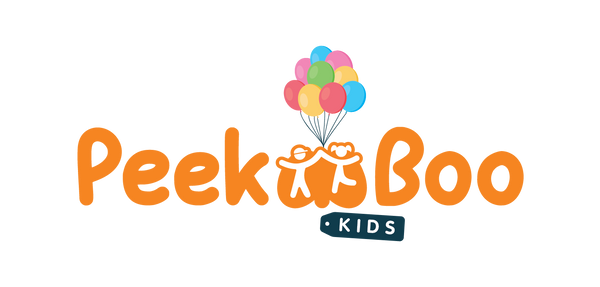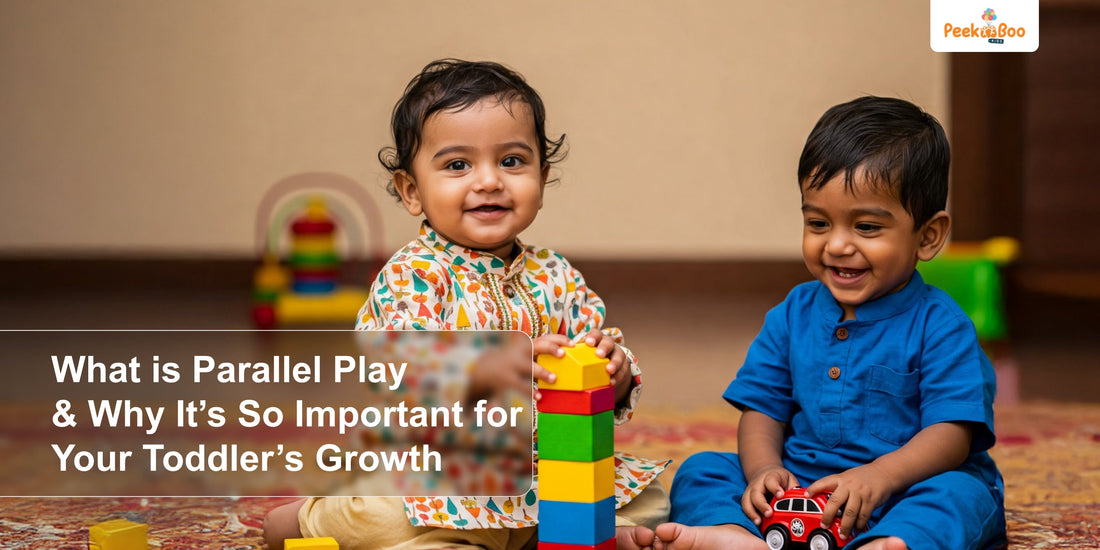If your toddler prefers sitting beside another child rather than playing with them, don’t worry—it’s not a sign of being shy or unfriendly. It’s actually a healthy and essential stage in their development known as parallel play. And believe it or not, it’s laying the foundation for confidence, language skills, and emotional awareness.
In this blog, we’re breaking down everything you need to know about parallel play—what it is, when it happens, and how you can support it (including dressing your little one in the comfiest clothes to move and explore freely).
What is Parallel Play?
Parallel play is a developmental phase where toddlers play next to each other without directly interacting. Each child is focused on their own game like stacking blocks or drawing but they’re still aware of one another.
For example, two children might:
-
Build towers with blocks side-by-side,
-
Sit and colour at the same table,
-
Push toy cars around on the floor without sharing them.
Even though they aren’t talking or collaborating, they’re still absorbing a lot just by being around each other. It’s all part of how children begin to socialize.
Parallel Play Definition
The definition of parallel play is simple: It occurs when kids play close to one another without attempting to lead or influence one another. Even if a kid does their own thing, they are still gaining new things from the people around them.
Child development experts say that this stage encourages social comfort, imitation, and observation. The definition of parallel play also emphasizes how children are developing important social and communication skills even in the absence of direct engagement.
Why Parallel Play is Important
In Indian households, where families are often closely knit and social milestones are closely watched, it’s easy for parents to worry when a child doesn’t “join in.” But parallel play is normal and essential—a stepping stone to more interactive play styles.
Here’s what your toddler gains through parallel play:
-
Social awareness: They learn how to exist in shared spaces.
-
Confidence: They feel safe being themselves around others.
-
Language skills: They pick up words and tone just by listening.
-
Independence: They begin to enjoy their own space while adjusting to group settings.
When Does Parallel Play Begin?
Most toddlers begin parallel play around 2 to 3 years of age. This is when they’re becoming more aware of others but may not be ready to share or communicate much yet.
By understanding the right parallel play age, parents will understand what to expect from their child. By understanding the right parallel play age, parents will understand what to expect from their child. Some children may show this behaviour earlier, while others may take their time. Every child is unique and has a different personality. Parents must support their toddler during this parallel play age helps them feel confident in social gatherings and prepares them for cooperative play in the future.
That said, every child is different. Some might start earlier, others later. The goal isn’t to rush it, but to create the right environment—like providing a safe play space, age-appropriate activities, and breathable clothes that let them move comfortably.
At Peekaaboo, we recommend soft, stretchable playtime outfits like:
-
Cotton rompers for all-day comfort
-
Easy-to-wear coord sets for daycare or playdates
-
Breezy t-shirts and shorts for active little explorers
The 6 Stages of Play (Based on Mildred Parten’s Theory)
Understanding the stages of play can help you see where your toddler stands—and where they’re heading next.
|
Stage |
Age Range |
Behaviour |
|
Unoccupied Play |
0–3 months |
Random movements, not yet purposeful. |
|
Solitary Play |
0–2 years |
Child plays alone, unaware of others. |
|
Onlooker Play |
2–2.5 years |
Watches others without joining. |
|
Parallel Play |
2–3+ years |
Plays side-by-side, not together. |
|
Associative Play |
3–4 years |
Begins interaction without clear rules. |
|
Cooperative Play |
4+ years |
Group play with shared goals. |
Parallel play is that gentle middle step between observing and fully engaging.
Benefits of Parallel Play for Your Toddler
Let’s dig into how this stage helps your little one grow:
1. 📚 Language Development
Even if kids aren’t talking to each other, they’re always listening. They hear new words, tone, and expressions, which improves:
-
Vocabulary
-
Sentence structure
-
Social cues like turn-taking in conversation
2. 🧠 Cognitive Growth
Children watch others, learn new ideas, and problem-solve independently. This enhances:
-
Observation skills
-
Memory
-
Imaginative thinking
3. 🖍️ Fine & Gross Motor Skills
Whether it’s drawing or pretending to cook in a toy kitchen, their movement improves coordination and muscle control.
Pro tip: Dress them in soft cotton joggers or leggings from Peekaaboo for unrestricted movement during active play.
4. 🧍 Confidence & Independence
Your toddler begins enjoying their own space without needing help, praise, or approval—building long-term self-esteem.
5. ❤️ Social Comfort
Being around other kids—even without talking—helps them feel safe in groups. It’s especially useful for introverted or shy children.
Real-Life Examples of Parallel Play in India
Here are some day-to-day Indian scenarios where you’ve probably seen parallel play in action:
-
Cousins playing together at nani’s house, each with their own toy.
-
Kids in a daycare sitting side-by-side during craft time.
-
Siblings painting or scribbling, but not on the same page.
-
Playground time, where two toddlers go down the slide one after another without chatting.
Encourage your child by dressing them for the activity. Think easy-to-wash dungarees, stretchy tees, or comfy kurta-pajamas during festive family events where kids are likely to play around each other.
How to Encourage Parallel Play at Home
You don’t need fancy setups or expensive toys. Just a few simple practices can support your toddler’s social and emotional growth:
✔️ Set Up a Shared Play Space
Lay down a mat or designate a low table where multiple kids can sit side by side, each with their own items.
✔️ Avoid Forcing Interaction
Let kids take their time. Parallel play is about sharing space, not toys or conversations.
✔️ Offer Duplicate Items
To avoid conflict, give each child their own set of crayons, blocks, or books.
✔️ Keep Them Comfortable
Dress your child in breathable clothes with no tight elastics or zippers. Happy kids = longer playtime.
🛒 Explore Peekaaboo’s 2–4 Years Collection for soft, fuss-free outfits perfect for playdates, daycare, and messy creativity.
🎯 Final Takeaways
-
Parallel play is a natural developmental phase where kids play next to each other without interacting.
-
It typically begins between ages 2–3, but every child has their own pace.
-
This stage supports language development, independence, confidence, and social comfort.
-
As a parent, you can encourage it by creating space, offering simple activities, and dressing your child for movement and mess.
-
And remember not all learning looks like loud interaction. Sometimes, magic happens quietly—block by block, page by page, moment by moment.
👗 Peekaaboo Tip: Dress for the Play They Deserve
From everyday wear to festive coords, Peekaaboo’s toddler clothing is designed for movement, mischief, and milestones. Soft fabrics, playful prints, and zero-fuss fits mean your little one can focus on growing—while you capture every cute moment.
🛍️ Shop Play-Ready Clothing for Toddlers (Ages 1–4)
Also Read :
- Parenting Tips: The Ultimate Guide to Spending Quality Time with Your Kids
- Screen-Free Time: Cultivating Creativity and Connection
- The Best Ways to Celebrate Valentine's Day with Your Family
- 5 Famous Akbar Birbal Moral Stories for Kids
- 10 Short Panchatantra Stories in English for Kids
- Celebrating Holi with Family: A Fun-Filled Guide for Indian Parents
- A Guide to Woven Cotton Weaves and Knits: Discover the Best Summer Fabrics for Toddlers
- Why Cotton (Natural) Fabric is the Best Choice for Kids Apparel in Indian Summer
- How to Choose the Perfect Christmas Clothing for Kids: A Parent's Guide
FAQs About Parallel Play in Toddlers
1. What is parallel play in child development?
Parallel play is when toddlers play side by side without directly interacting. They may be doing their own activities like building blocks or coloring, but they’re still learning by observing each other. It’s a natural stage of social development.
2. At what age does parallel play typically start?
Parallel play usually begins between 2 to 3 years of age, though some children may show signs earlier or later. Every child is unique, so the timeline can vary.
3. Is it normal if my toddler doesn’t interact with other kids during playtime?
Absolutely. If your toddler prefers to play independently next to others, it’s likely they’re in the parallel play stage. It’s not a sign of shyness or delay—it’s a healthy step in their social growth.
4. How can I encourage parallel play at home?
You can support parallel play by:
- Setting up a shared play space
- Providing duplicate toys to avoid conflict
- Letting kids play without forcing interaction
- Dressing your toddler in soft, comfy clothes for free movement
5. What are the benefits of parallel play for toddlers?
Parallel play helps your child:
- Develop language and communication skills
- Gain confidence and independence
- Improve observation and cognitive abilities
- Build comfort in group settings without pressure
6. Is parallel play the same as solitary play?
No, they’re different stages. Solitary play happens when a child plays completely alone, usually before age 2. Parallel play involves being near other children and becoming more socially aware, even if there’s no direct interaction.
7. Can siblings engage in parallel play?
Yes! Siblings often engage in parallel play, especially if they’re close in age. It helps them become more comfortable with each other and sets the stage for future cooperative play.
8. What type of clothing is best for toddlers during play?
Look for outfits that are:
- Soft and breathable (like cotton rompers or tees)
- Easy to move in (stretchy joggers or leggings)
- Easy to wash (for those messy play sessions)
Peekaaboo offers toddler-friendly styles perfect for active play and daycare.
9. Does parallel play help with school readiness?
Yes, it does. By building confidence, listening skills, and comfort around other kids, parallel play prepares toddlers for structured group environments like preschool.
10. How do I know when my toddler is moving to the next stage of play?
You’ll notice them starting to share, talk to others, or join in group games. That’s a sign they’re entering associative or cooperative play, the next stages after parallel play.

